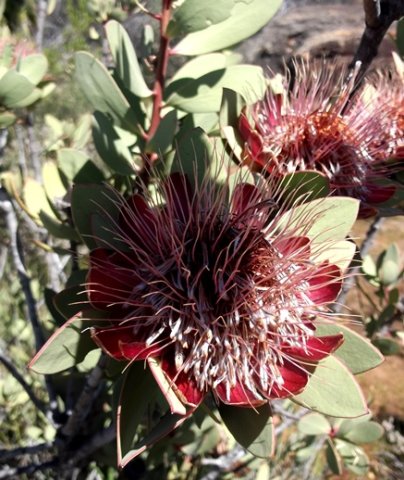Protea punctata

Author: Ivan Lätti
Photographer: Thabo Maphisa
Protea punctata, commonly the water sugarbush and in Afrikaans the waterwitsuikerbos (water white sugarbush), is a single-stemmed, branched shrub growing to heights between 2 m and 4 m (SA Tree List 94.1). The base of the stem may become 30 cm in diameter. The bark on old stems is smooth and grey to brownish.
The leaves are stalkless, ascending on the stems. The leaf shape is ovate to obovate or elliptic and curving up. The leaf tips taper obtusely, acutely or are rounded, the base broadly tapering and the margins entire. The dull bluish green to blue-grey leaf surfaces are covered in shaggy, long hairs when young, losing the hairs as they age. Leaf dimensions are 3,5 cm to 8,5 cm by 2 cm to 4,5 cm.
The specific name, punctata, is derived from the Latin word, punctum, meaning a point, referring to the very small dots or translucent depressions upon the leaf surfaces, the stomata that are only visible under a magnifying glass.
The species is mainly found inland in the Western Cape from the Cederberg and the Riviersonderend Mountains eastwards, spilling over into the west of the Eastern Cape as far as the Kouga Mountains and Baviaanskloof.
The habitat is fynbos on rocky, north-facing slopes of the inland mountain ranges. The habitat population is deemed of least concern early in the twenty first century (Euston-Brown and Kruger, 2023; Manning, 2007; Coates Palgrave, 2002; Rebelo, 1995; Rourke, 1980; iNaturalist; http://redlist.sanbi.org).

